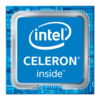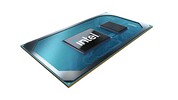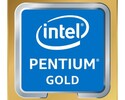Intel Celeron 5305U vs Intel Core i5-1145G7 vs Intel Pentium Gold 6405U
Intel Celeron 5305U
► remove from comparison
The Intel Celeron 5305U is a low-power dual-core SoC for laptops, based on the Comet Lake architecture, which was introduced in 2020. Compared to Kaby Lake and Whiskey Lake, there are apparently no differences with Comet Lake apart from the two additional cores in the Top model Core i7-10710U. The processor is still manufactured using the mature 14nm process (14nm++ like Whiskey Lake). The processor cores clock at a fixed 2.3 GHz (no Turbo) and also only offer 2 threads (no HyperThreading). Compared to the more powerful Core i3, i5 and i7 variants, the Celeron does not offer SSE (2) support.
You can find more information about the Comet Lake architecture and the available processors on our Comet Lake topic page.
According to Intel, the integrated graphics card is called Intel UHD Graphics, but is an old Intel UHD Graphics 610. It is clocked in the Celeron 5205U at 300 - 900 MHz and is only sufficient for very demanding games. The CPU also offers an integrated DDR4-2666 / LPDDR4x 2933 / LPDDR3-2133 dual-channel memory controller as well as VP9 and H.265 video decoder and encoder.
Performance
The performance of the Celeron 5305U is in the lowest entry-level class of notebook processors in 2020. Due to the lack of Turbo and only 2 cores, the CPU cannot score points in either single-core or multi-core tasks. The processor is therefore only suitable for undemanding tasks such as surfing with a few tabs and office tasks.
The power consumption and performance can be set from 15 to 12.5 watts by the notebook manufacturer via cTDP-down. However, the processor then only runs at 800 MHz and significantly reduced performance. Even at 15 watts, however, the processor is suitable for thin and light notebooks.
Intel Core i5-1145G7
► remove from comparison
The Intel Core i5-1145G7 is a power efficient quad-core SoC for laptops and Ultrabooks based on the Tiger Lake-U generation that was announced early 2021. It integrates four Willow Cove processor cores (8 threads thanks to HyperThreading). The base clock speed depends on the TDP settings and ranges from 1.1 GHz (12 Watt TDP) up to 2.6 GHz (28 Watt). The Boost is always specified at 4.4 GHz (one or two cores).
Another novelty is the integrated Xe graphics card with 80 EUs based on the completely new Gen 12 architecture. It offers a significantly higher performance compared to the older Iris Plus G7 (Ice Lake).
Furthermore, Tiger Lake SoCs add PCIe 4 support (4 lanes), AI hardware acceleration, and the partial integration of Thunderbolt 4 / USB 4 and Wifi 6 in the chip. In addition to this, the i5 supports vPro for easy remote management.
The chip is produced on the improved 10nm SuperFin process at Intel that should be comparable to the 7nm process at TSMC (e.g. Ryzen 4000 series).
All articles on Tiger Lake can be found on our Tiger Lake architecture hub.
Intel Pentium Gold 6405U
► remove from comparison
The Intel Pentium Gold 6405U is a power efficient entry-level dual-core SoC for notebooks based on the Comet Lake (CML-U) generation and was announced in October 2019. Compared to the similar Whiskey Lake Pentium 5405U processors, the difference is the higher clock speed (+100 MHz) and support for faster memory. The processor cores are clocked at 2.4 GHz (no Turbo). Thanks to HyperThreading 4 threads can be used. More information on Comet Lake and all the models and articles on it can be found here.
Due to the 100 MHz higher clock speed, the Pentium Gold 6405U should be slightly faster than the old Pentium 5405U and therefore in the entry level of mobile processors. The missing Turbo and only two cores are definitely a downside and therefore the CPU is best used for simple tasks like browsing and office programs. Compared to the faster Core i3, i5 and i7 Comet Lake models, the Pentium does not support SSE (2).
The integrated graphics card is still the same as in the previous generations. It is called only Intel UHD Graphics but is still the same Intel UHD Graphics 610 like in the Pentium 5405U. Furthermore, the SoC integrates a VP9 and H.265 de- and encoder and an integrated dual channel LPDDR3-2133/DDR4-2400 memory controller (compared to DDR4-2666 in the faster Core i3).
The chip is still produced in the 14nm++ process as Whiskey Lake. The TDP (PL1) is specified at 15 Watts but can be lowered to 12.5 Watt although the CPU then only runs at 800 MHz.
| Model | Intel Celeron 5305U | Intel Core i5-1145G7 | Intel Pentium Gold 6405U | ||||||||||||||||||||||||||||||||||||||||||||||||||||||||||||||||||||||||||||||||||||||||||||||||||||||||||||||||
| Codename | Comet Lake-U | Tiger Lake-UP3 | Comet Lake-U | ||||||||||||||||||||||||||||||||||||||||||||||||||||||||||||||||||||||||||||||||||||||||||||||||||||||||||||||||
| Series | Intel Comet Lake | Intel Tiger Lake | Intel Comet Lake | ||||||||||||||||||||||||||||||||||||||||||||||||||||||||||||||||||||||||||||||||||||||||||||||||||||||||||||||||
| Series: Comet Lake Comet Lake-U |
|
|
| ||||||||||||||||||||||||||||||||||||||||||||||||||||||||||||||||||||||||||||||||||||||||||||||||||||||||||||||||
| Clock | 2300 MHz | 2600 - 4400 MHz | 2400 MHz | ||||||||||||||||||||||||||||||||||||||||||||||||||||||||||||||||||||||||||||||||||||||||||||||||||||||||||||||||
| Cores / Threads | 2 / 2 | 4 / 8 | 2 / 4 | ||||||||||||||||||||||||||||||||||||||||||||||||||||||||||||||||||||||||||||||||||||||||||||||||||||||||||||||||
| TDP | 15 Watt | 28 Watt | 15 Watt | ||||||||||||||||||||||||||||||||||||||||||||||||||||||||||||||||||||||||||||||||||||||||||||||||||||||||||||||||
| Technology | 14 nm | 10 nm | 14 nm | ||||||||||||||||||||||||||||||||||||||||||||||||||||||||||||||||||||||||||||||||||||||||||||||||||||||||||||||||
| max. Temp. | 100 °C | 100 °C | 100 °C | ||||||||||||||||||||||||||||||||||||||||||||||||||||||||||||||||||||||||||||||||||||||||||||||||||||||||||||||||
| Socket | BGA1528 | BGA1449 | FCBGA1528 | ||||||||||||||||||||||||||||||||||||||||||||||||||||||||||||||||||||||||||||||||||||||||||||||||||||||||||||||||
| Features | LPDDR3-2133/DDR4-2400 RAM, PCIe 2, 4 GT/s bus, MMX, SSE, SSE2, SSE3, SSSE3, SSE4.1, SSE4.2, AVX, AVX2, BMI2, ABM, FMA, ADX, VMX, SMEP, SMAP, MPX, EIST, TM1, TM2, SST, AES-NI, RDRAND, RDSEED, SGX | DDR4-3200/LPDDR4x-4266 RAM, PCIe 4, 4 GT/s bus, DL Boost, GNA, vPro, MMX, SSE, SSE2, SSE3, SSSE3, SSE4.1, SSE4.2, AVX, AVX2, AVX-512, BMI2, ABM, FMA, ADX, VMX, SMX, SMEP, SMAP, EIST, TM1, TM2, HT, Turbo, SST, AES-NI, RDRAND, RDSEED, SHA, TME | Dual-Channel DDR4 Memory Controller, HyperThreading, AVX2, Quick Sync, Virtualization, AES-NI | ||||||||||||||||||||||||||||||||||||||||||||||||||||||||||||||||||||||||||||||||||||||||||||||||||||||||||||||||
| iGPU | Intel UHD Graphics 610 (300 - 900 MHz) | Intel Iris Xe Graphics G7 80EUs (400 - 1300 MHz) | Intel UHD Graphics 610 (300 - 900 MHz) | ||||||||||||||||||||||||||||||||||||||||||||||||||||||||||||||||||||||||||||||||||||||||||||||||||||||||||||||||
| Architecture | x86 | x86 | x86 | ||||||||||||||||||||||||||||||||||||||||||||||||||||||||||||||||||||||||||||||||||||||||||||||||||||||||||||||||
| $107 U.S. | $161 U.S. | ||||||||||||||||||||||||||||||||||||||||||||||||||||||||||||||||||||||||||||||||||||||||||||||||||||||||||||||||||
| Announced | |||||||||||||||||||||||||||||||||||||||||||||||||||||||||||||||||||||||||||||||||||||||||||||||||||||||||||||||||||
| Manufacturer | ark.intel.com | ark.intel.com | ark.intel.com | ||||||||||||||||||||||||||||||||||||||||||||||||||||||||||||||||||||||||||||||||||||||||||||||||||||||||||||||||
| L1 Cache | 320 KB | 256 KB | |||||||||||||||||||||||||||||||||||||||||||||||||||||||||||||||||||||||||||||||||||||||||||||||||||||||||||||||||
| L2 Cache | 5 MB | 1 MB | |||||||||||||||||||||||||||||||||||||||||||||||||||||||||||||||||||||||||||||||||||||||||||||||||||||||||||||||||
| L3 Cache | 8 MB | 2 MB |
Benchmarks
Average Benchmarks Intel Celeron 5305U → 0% n=0
Average Benchmarks Intel Core i5-1145G7 → 0% n=0
Average Benchmarks Intel Pentium Gold 6405U → 0% n=0
* Smaller numbers mean a higher performance
1 This benchmark is not used for the average calculation













